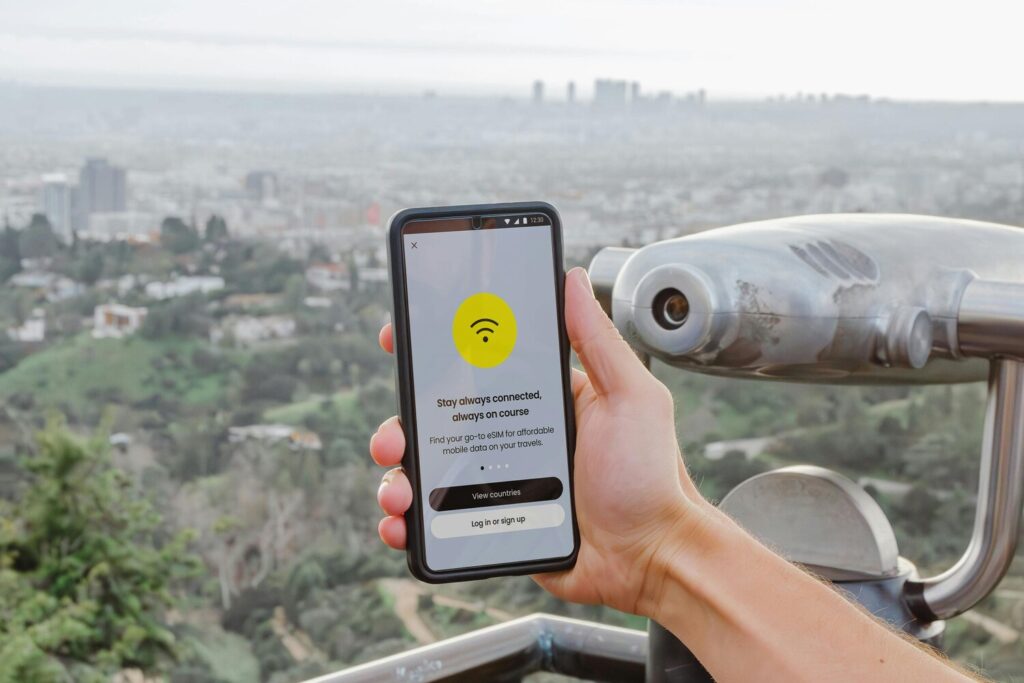
T-Mobile Review: The Best eSIM for Travel in 2025?
T-Mobile is one of the biggest names in the global telecom space, with strong roots in the US and connections to international markets through its parent company, Deutsche Telekom. Its core services operate in the United States, but travelers and digital nomads will definitely be pleased to know that T-Mobile plans often include international data and texting in more than 200 countries – yep, you heard that number correctly.
So, there’s no doubt about the fact that T-Mobile is a great option for those who frequently cross borders. In addition, it’s especially appealing for budget-conscious travelers, remote workers, and business professionals who despise the prospect of having to fuss with SIM swaps or surprise roaming charges, which are a logistical nightmare and a financial gut punch, respectively.
Known for its competitive pricing in the world of eSIMs, unlimited data plans, and expanding 5G coverage, buzzwords surrounding T-Mobile include “convenience” and “flexibility”, whether you’re hopping between US cities or working remotely abroad.
So, in this review, we’ll explore pricing, coverage, speed, and ease of use, while highlighting pros and cons to help you decide if T-Mobile is the right fit for your mobile lifestyle – both at home or while you’re on the move.
Overview of T-Mobile
T-Mobile US, Inc., established in 1994 as VoiceStream Wireless and rebranded in 2001 following Deutsche Telekom’s acquisition, has evolved into a leading wireless network operator now headquartered in Bellevue, Washington.
With a majority stake held by Deutsche Telekom, T-Mobile has expanded its services through strategic acquisitions, including the 2020 merger with Sprint and the 2024 acquisitions of Mint Mobile and Ultra Mobile – all big moves.
Competing with big-name eSIM providers like Airalo, Nomad, and Holafly, T-Mobile distinguishes itself by offering robust domestic and international coverage, catering to both U.S. residents and travelers. Its extensive 5G network and customer-centric approach have earned it numerous accolades over recent years, most notably its inclusion in Time’s list of influential companies in 2024.
T-Mobile at a Glance
- Coverage: Extensive U.S. nationwide coverage with expanding international roaming options.
- Network: Advanced 5G infrastructure providing high-speed connectivity.
- Pricing: Competitive plans with options for various needs, including unlimited data.
- App Usability: User-friendly interface for account management and support.
- Activation: Streamlined eSIM activation process for compatible devices.
Coverage and Network Reliability
A massive component of what makes one eSIM provider better than its competitors is network reliability and its coverage.
Supported Countries
T-Mobile offers extensive international coverage, providing service in over 210 countries and destinations. This includes most of Europe, North and South America, and significant parts of Asia and Oceania.
But, coverage may be limited or unavailable in certain regions, especially parts of Africa and the Middle East.
Network Partners
T-Mobile collaborates with various local carriers to ensure reliable service abroad, and it’s a great tactic.
In Europe, partnerships with providers like Orange and Deutsche Telekom facilitate strong connectivity. In North America, T-Mobile’s own network, bolstered by its merger with Sprint and acquisition of U.S. Cellular’s wireless operations, offers extensive coverage across the board.
The company consistently provides 4G and 5G services, depending on the region and local infrastructure.
Performance by Region
T-Mobile’s international performance varies depending on the region, influenced by its local carrier partnerships and the availability of 4G/5G infrastructure. While the provider generally delivers reliable service across popular destinations, connectivity and speed can fluctuate, especially in remote or less-developed areas. Here’s a breakdown of performance by region:
Europe: Strong coverage and fast speeds in most European countries.
North America: Excellent coverage across the US, with solid roaming support in Canada and Mexico.
Asia: Performance is solid in countries like Japan and South Korea but limited/inconsistent in places like China and India.
South America and Africa: Connectivity is available in major cities, but rural areas often experience slower speeds and patchy coverage.
Data Plans & Pricing
T-Mobile offers a variety of eSIM plans tailored to different user needs, including pay-as-you-go options, unlimited data plans, regional packages, and global bundles. Their offerings are designed to provide flexibility for both short-term travellers and long-term users.
Types of Plans Available:
- Pay-as-you-go: Great for users who require data for a short period without a long-term commitment.
- Unlimited Data Plans: Suitable for heavy data users, these plans offer unrestricted data usage.
- Regional Packages: These plans provide coverage within specific regions, such as Europe or North America.
- Global Bundles: Designed for international travellers, offering coverage across multiple countries.
Pricing Breakdown:
T-Mobile’s eSIM plans are competitively priced. For instance, a 1-day pass with 512MB of data is available for $5, a 10-day pass with 5GB for $35, and a 30-day pass with 15GB for $50. While there are no explicit discounts for long-term users, the variety of plans allows users to choose options that best fit their usage patterns.
Cost Comparison Vs. Competitors:
When compared to providers like Airalo, Nomad, and Holafly, T-Mobile’s eSIM plans are competitively priced.
For example, Airalo offers 10GB for $37 in Europe, while Holafly provides unlimited data for 30 days at €69. T-Mobile’s 30-day plan with 15GB for $50 offers a balance between data allowance and cost, making it a viable option for many users.
Hidden Fees and Validity:
T-Mobile’s eSIM plans are straightforward, with no hidden fees which is always a good thing. Data expiration aligns with the validity period of the chosen plan.
Also, T-Mobile supports hotspot and tethering functionalities without extra charges, providing added value for users who need to share their connection.
| Data Allowance | Price | Validity | Coverage |
| 512 MB | $5 | 1 Day | Global |
| 5 GB | $35 | 10 Days | Global |
| 15 GB | $50 | 30 Day | Global |
Internet Speed & Network Performance
T-Mobile’s eSIM service generally delivers strong performance when it comes to speed and reliability, particularly in major urban centres across Europe and North America. In many regions, users report download speeds averaging between 100-300 Mbps, depending on local infrastructure. While T-Mobile advertises 5G access, real-world testing shows that in some areas, users may receive high-speed 4G LTE instead, especially in more rural or congested zones, so that’s definitely something to be aware of.
In terms of latency, T-Mobile performs well for most everyday uses. Video streaming, online gaming, and video conferencing are usually smooth and uninterrupted. Latency often ranges between 20-40ms on 5G, making it a good choice for time-sensitive activities.
Super importantly, there are no widely reported throttling issues unless users hit data limits on capped plans. Unlimited plans tend to maintain consistent speeds, although some prioritisation during network congestion may occur.
User feedback is largely positive, with most praising the ease of setup and reliable connection speeds. Some users have noted slight slowdowns during peak hours in busy city centres, but these are generally brief and manageable.
Overall, T-Mobile’s eSIM service offers dependable speed and reliability for travel, work, and leisure – thus, it’s a pretty solid choice for both occasional users and digital nomads alike.
Ease of Use and Setup Process
Getting started with a T-Mobile eSIM is refreshingly simple, even if you’re not especially tech-savvy. To purchase and activate, just visit T-Mobile’s website or app – it’s as easy as that.
From there, choose your plan (such as a global bundle or pay-as-you-go option), create an account, and proceed to checkout. Once you’ve paid, you’ll receive a QR code or activation link via email. Simply scan the QR code with your phone’s settings under “Mobile Data” or “Add eSIM,” and you’re ready to go. No physical SIM, no fuss – no problems at all, just convenience.
T-Mobile’s app is clean, intuitive, and easy to navigate. Everything you need is right there on the dashboard – from checking your balance and data usage, to topping up or switching plans on the fly. It also sends useful alerts as you approach your data limit, helping you avoid any unexpected slowdowns.
When it comes to customer support, T-Mobile doesn’t disappoint. Live chat and phone support are available 24/7, while email responses usually arrive within a few hours. The in-app help section is also quite detailed, offering step-by-step instructions and FAQs for most issues. Users often report quick, friendly assistance and minimal hold times.
All in all, the setup process and ongoing management of your eSIM with T-Mobile is designed to be as straightforward and stress-free as possible – exactly what you want when travelling or working remotely (or honestly, just in general.
Pros and Cons of T-Mobile
Every service provider has its ups and downs – so here are T-Mobile’s pros and cons.
✔ Pros:
✔ Easy eSIM activation process with QR code or app
✔ Competitive global and regional data plans
✔ Reliable speeds with access to 5G in lots of areas
✔ User-friendly app for managing data, balance, and plan changes
✔ No hidden fees or charges for hotspot/tethering
✔ 24/7 customer support via live chat, phone, and email
✔ Strong performance for streaming, gaming, and video calls
✔ Wide coverage across multiple countries
❌ Cons:
❌ 5G not always available – often defaults to 4G in some regions
❌ No major discounts for long-term users
❌ Occasional slowdowns during peak hours in busy locations
❌ App interface could be more detailed in plan comparisons
❌ Limited customisation of data plans (compared to some competitors)
So, take a look at these pros and cons, decide what’s most important for you and your needs, and then you can make a choice.
Who Should Use T-Mobile?
It really depends on your travel habits, data needs, and how much flexibility you’re after. Here’s a quick breakdown of who T-Mobile is ideal for and who might want to look elsewhere:
Ideal For: ✔
✔ Frequent travelers hopping between multiple countries
✔ Digital nomads and remote workers needing reliable data
✔ People who want quick, hassle-free eSIM activation
✔ Users who appreciate a clean, easy-to-use app
✔ Those looking for flexible short-term or regional plans
✔ Travelers who need solid customer support around the clock
Not Ideal For: ❌
❌ People who stay in one country long-term – local SIMs may be cheaper
❌ Heavy data users wanting unlimited high-speed access everywhere
❌ Users who want fully customisable or highly tailored data plans
❌ Travelers heading to very remote areas with limited T-Mobile coverage
How Does T-Mobile Compare To Other eSIM Providers?
| Coverage | Pricing | Speed | User Experience | |||
| T-Mobile | Excellent global coverage (especially strong in North America and Europe) | Competitive, especially for regional & pay-as-you-go plans | Fast and reliable; 5G in many areas, solid 4G fallback | ⭐⭐⭐⭐ | ||
| Airalo | Widely available in 190+ countries |
| ⭐⭐⭐⭐ | |||
| Holafly |
| Generally higher; unlimited plans available but pricey | Decent speeds, mostly 4G with occasional 5G in select regions | ⭐⭐⭐ |
T-Mobile holds its own against top eSIM providers like Holafly and Airalo, particularly when it comes to speed, reliability, and ease of use.
While Holafly offers unlimited plans and Airalo shines with ultra-budget options, T-Mobile strikes a strong balance between performance and pricing. It offers true 5G in many regions, a smooth setup process, and 24/7 customer support – something not all competitors can match.
T-Mobile is especially well-suited for frequent or long-term travelers who need reliable data across several countries. It’s also ideal for digital nomads, remote workers, and business travelers who depend on consistent speeds and real-time communication. Short-term tourists might find cheaper deals elsewhere, but for regular travel, T-Mobile is a dependable choice.
If you’re on a tight budget or only need a small amount of data, Airalo is a great alternative with ultra-flexible, low-cost plans. For travelers wanting unlimited data for short trips without worrying about usage limits, Holafly might be a better fit – just be mindful of device compatibility and hotspot restrictions.
So, Is T-Mobile Worth The Hype?
T-Mobile’s eSIM service offers a reliable and user-friendly option for global travelers looking for consistent connectivity. One of its best features is the strong network performance – lots of users enjoy fast, stable data with access to true 5G in select regions and solid 4G fallback elsewhere.
The setup process is simple, and the T-Mobile app makes it easy to manage your plan, check your balance, and top up on the go. Another standout is 24/7 customer support, which adds peace of mind when you’re abroad.
However, there are a few drawbacks. While pricing is competitive for most plans, it’s not always the cheapest option – especially for short trips or light data use. Long-term users may also wish there were more loyalty discounts. And although coverage is excellent in North America and Europe, speeds can dip in some remote areas.
Overall, T-Mobile is worth the price for digital nomads, business travelers, and frequent flyers who value speed, reliability, and support. It’s a solid pick over competitors like Airalo or Holafly if you’re after performance and ease rather than just the lowest price.
Would we recommend it? Absolutely – especially if you want a no-fuss, dependable eSIM experience wherever you travel.








Responses